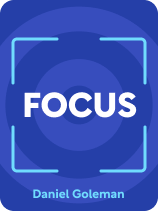

This article is an excerpt from the Shortform book guide to "Focus" by Daniel Goleman. Shortform has the world's best summaries and analyses of books you should be reading.
Like this article? Sign up for a free trial here.
How is attention like a muscle? How is it like a camera?
Daniel Goleman argues that attention is a complex and underappreciated cognitive resource in our modern society overrun with distractions. He shares three characteristics of attention: it’s indivisible, it’s like a muscle, and it’s like a camera.
Keep reading to learn what Goleman means and to understand attention better.
Characteristics of Attention
Goleman describes attention as an elusive and subtle mental asset. He writes that we tend to notice what abilities attention gives us, like learning and connecting to others, more than we notice attention itself.
(Shortform note: In describing attention as elusive, Goleman alludes to the ongoing challenge in psychology and neuroscience to define it. Often it is defined similarly to the word focus—the deliberate act of concentrating your mind or effort on something. However, attention can encompass more than an act and can include your brain’s ability to be aware of yourself and your surroundings. To avoid confusion, we use the term attention to talk about this broader mental ability and focus to talk about the purposeful concentration of our attention.)
Goleman highlights three fundamental characteristics of attention that we must understand as we explore more specific aspects of this mental resource:
- Attention is indivisible. You can’t divide your attention between multiple things simultaneously, as in multitasking. You can only switch your attention back and forth between things.
- Attention is like a muscle. Its strength is limited, but it can be improved.
- Attention is like a camera. To achieve different goals you can move your attention in different directions and switch between focused and unfocused states.
(Shortform note: The first two characteristics of attention listed above describe your attention’s limitations, but, luckily, you can take advantage of the third characteristic to optimize your attention. You cannot try to divide your attention between multiple things or focus it for too long without depleting your attention capacity, but some experts suggest that switching your attention between focused and unfocused states throughout the day helps refresh and restore your attention capacity.)
Goleman highlights two system-wide processes in the brain and body—“bottom-up processing” and “top-down processing.”
Bottom-up processing is an involuntary cognitive process driven by raw sensory data, impulses, and emotions. With bottom-up processing, your responses to the world are rapid, instinctual, and habitual.
Top-down processing is a conscious, voluntary, and effortful cognitive process that integrates the information it receives from the bottom up and helps you deliberate and reason before responding.

———End of Preview———
Like what you just read? Read the rest of the world's best book summary and analysis of Daniel Goleman's "Focus" at Shortform.
Here's what you'll find in our full Focus summary:
- How to understand, strengthen, and use your attention to lead a more fulfilling life
- The three directions you can aim your attention: inward, toward others, and outward
- How spending time in nature restores your attention







In being born with mosaic Down syndrome where it’s a developmental disability I never knew there is a little understanding of what the mental milestones for creativity might be. That would be interesting on what I achieve on my own knowing my life is overrun with my distractions.